California Blueprint for Women’s Pandemic Economic Recovery
The California Commission on the Status of Women and Girls is deeply concerned by the systematic erosion of women’s well-being, human rights, and economic status that have been profoundly accelerated by COVID-19. This Blueprint, the first of its kind, centers the economic needs of women and girls as critical to the state’s economic recovery from the COVID-19 pandemic.
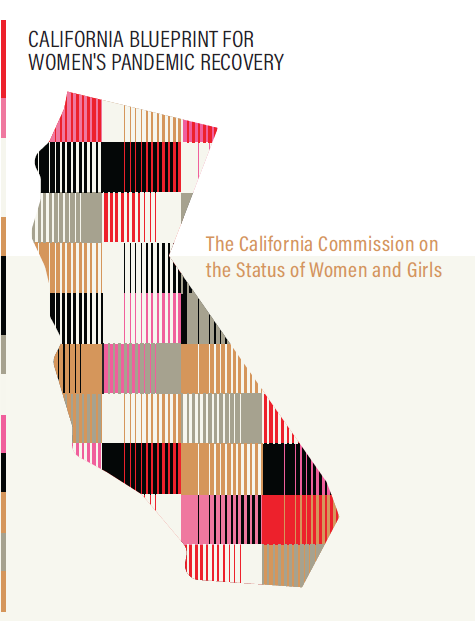
Women Are Essential To The Economy
During the first two years of the pandemic, women in the United States lost more than 5.4 million net jobs. Data shows that the economic crisis exacerbated the cumulative and collective crises women in California were already experiencing. The erosion of women’s well-being, human rights, and economic status will likely continue unless halted by deliberate policy interventions and strategic support from government and key stakeholders.
The California Commission on the Status of Women and Girls, in partnership with the California Research Bureau, conducted an initial literature review on the state of women in California for the Women’s Recovery Response effort launched in 2021. Studies consistently report that women, especially women of color, experienced greater loss in jobs, income, and childcare services. At the same time, concerns regarding their mental health grew at an alarming rate. In partnership with the California Policy Lab we conducted our own research that sheds light on points of pain and bright spots of hope for a more equitable economic recovery for women.
The California Commission on the Status of Women and Girls has constructed this statewide blueprint for a recovery response that centers women and supports deliberate gendered policy interventions, but it is only the first step. As California’s women and families grapple with the long-term consequences of the COVID-19 pandemic, it is imperative that impacted people with lived experience are empowered to inform policy decisions being made on their behalf, so that services and resources can be designed and implemented appropriately.
Explore our research and findings below or download our toolkit to help share the findings on social media.
Key Findings
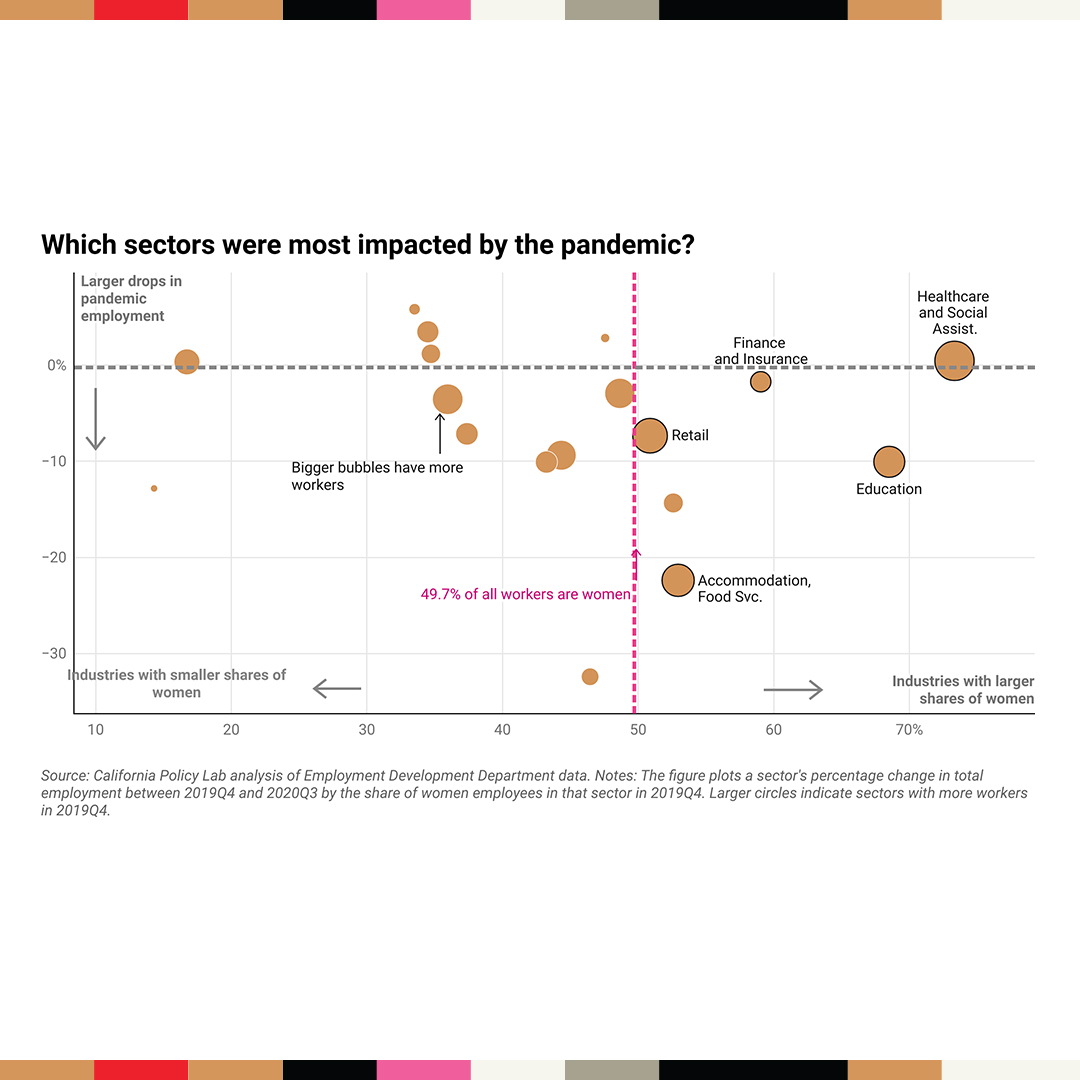
Women went into the pandemic worse off due to existing systemic inequities in the workforce, such as a persistent pay gap and occupational segregation.
Pandemic unemployment affected poor women, and women without college degrees, hardest. Frontline and service sectors, what we called “essential workers” were the most impacted. In many of these sectors women are occupationally segregated, making up in some cases more than 70% of a particular industry’s workforce. It is critical to understand that it is not just certain professions or service workers that we lauded as essential – it was women who dominate those sectors as employees. Women are essential to the economy.
Women of color in California, specifically, continue to see lower employment rates as a share of the population compared to white women.
Those who were employed prior to the pandemic earned an average of 78 cents on the dollar, held nearly half the retirement savings, and were enrolled in government safety net programs at three times the rate of men.
A significant number of households in California lived on incomes at or below the poverty line prior to the pandemic.
Prior to the pandemic, women in California were employed at a rate 20% lower than men, making them nearly half of the state’s workforce but a larger percentage of those struggling with poverty.
California’s 2019 median household income was $80,440 for all households ($65,712 for US) and $39,871 for nonfamily households with roughly 11.8% of Californians’ households (12.3% in the U.S.) living on incomes at or below the federal poverty designation. In 2019, roughly 17.2% of Californians (11.7% in the U.S.) had income insufficient to meet their basic housing needs and by 2020 an estimated 161,548 individuals experienced homelessness (single-night survey method).
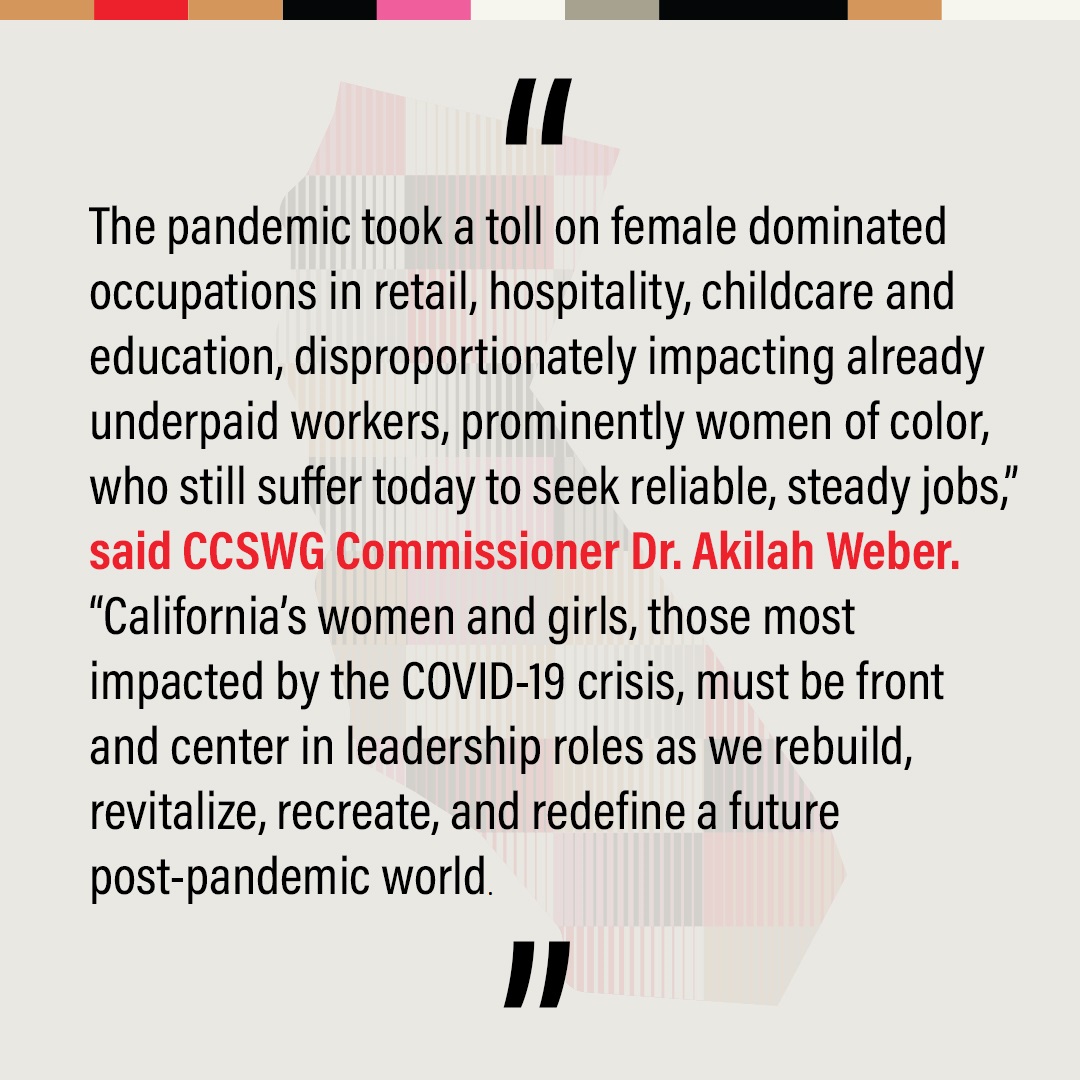
Women of color were the first to lose jobs and last to regain them, causing long-term financial stress to their households.
Prior to the pandemic, nearly half of all working women held low paying jobs, a significant percentage of which were held by women of color. These disparities continue to impact statewide recovery.
Women with disabilities were the most affected, leaving nearly 8% of this group jobless during the acute phase of the pandemic.
Nearly one in four (24.1%) non‐citizens lost their job, compared to almost one in six naturalized citizens (17.9%) and almost one in seven (14.5%) native‐born US citizens.
The pandemic shook the already unstable foundations of women’s economic security as the additional burdens of closed schools, family caregiving, and lack of childcare fell disproportionately on their shoulders.
The COVID-19 virus impacted men and women differently, with women facing an elevated risk of Long COVID and more significant impacts to their workforce participation, long term economic health, and ability to build wealth over time.
In California alone, it is estimated that between 12.9 and 14.9% of all adults living in the state have experienced symptoms consistent with Long COVID.
One study of nearly 4,000 Long COVID patients found that 45% reduced their work hours. For some, the change in job status can affect health insurance, interfere with childcare, or force exit from the workforce entirely.
There are roughly 257,000 full-time equivalent workers out of the California workforce due to Long COVID. This amounts to roughly $17.61 billion in annual lost earnings, which amounts to roughly half a percent of the total state economy (.49%).
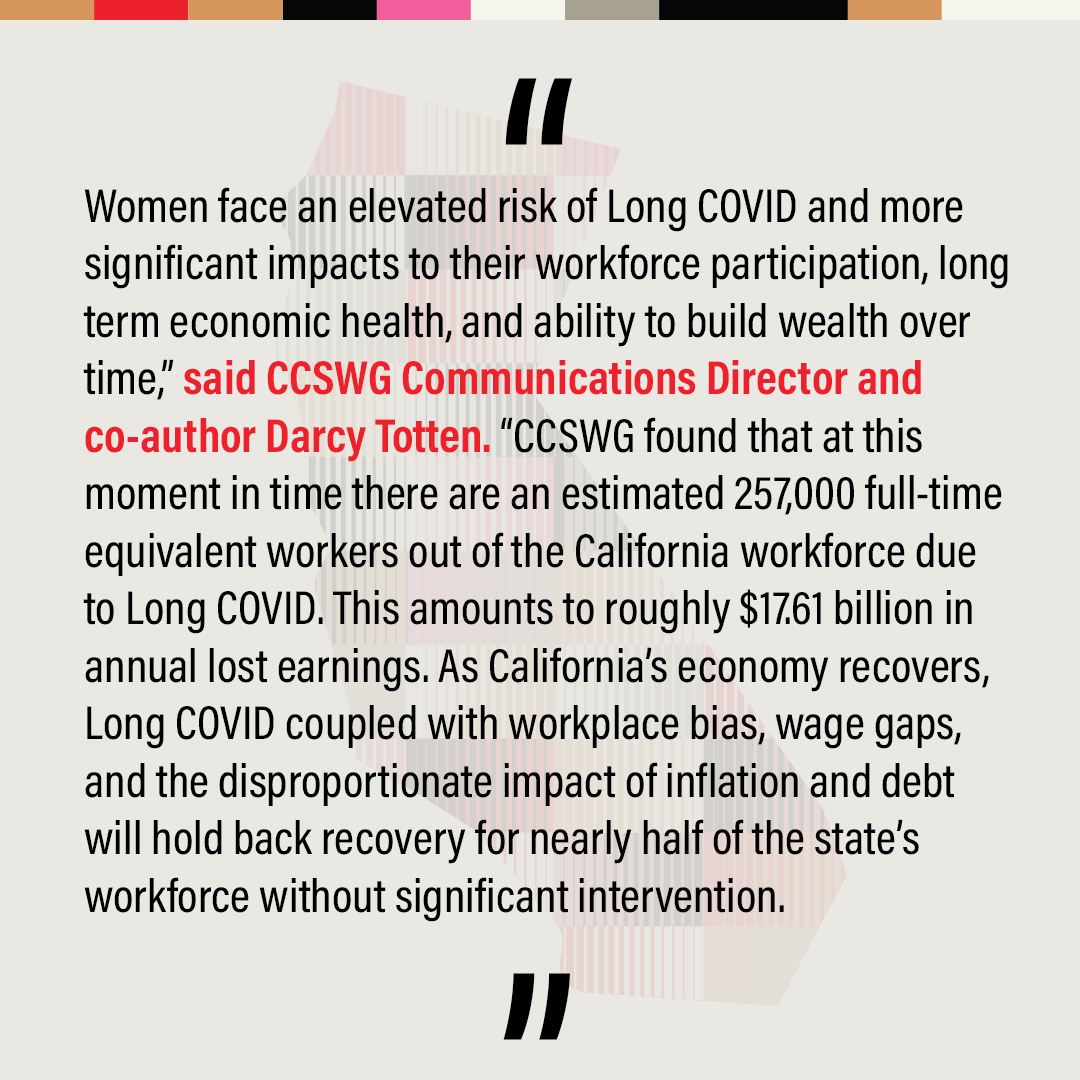
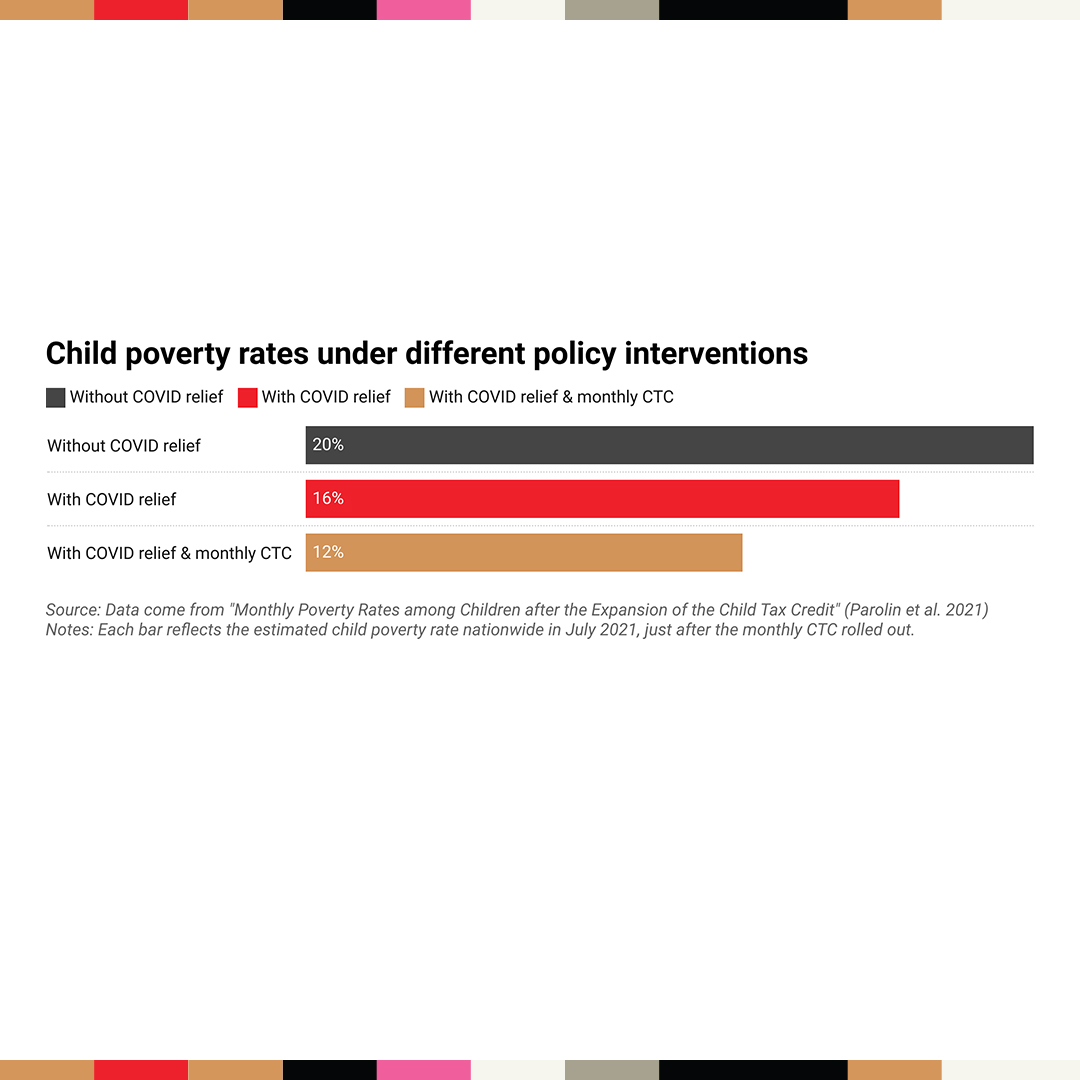
Pandemic response through government safety-net programs demonstrably helped women meet life’s basic needs, pay down debt, and significantly reduced child poverty, highlighting a path forward to an equitable economy.
183,000 more women relied on food assistance during the early pandemic, and enrollment in mid-2021 still stood 5% higher than before the pandemic.
There are nearly four million Californians with a total of over $140 billion in student loan debt. Pausing student debt played a role in the ability to improve access to credit and pay down credit card debt, another critical support for women during the pandemic.
On average, both women and men with access to credit cards saw their credit scores increase in 2020 and the first half of 2021 by 10-13 points.
Prior to the Federal and State social safety net programs deployed during the apex of the pandemic, national child poverty rates stood at 20%. With social safety net enhancements, that number dropped to 12%, effectively reducing child poverty by nearly half.
Contrary to the argument that unemployment benefits discourage work, the enhancement of these benefits helped low wage workers weather the crisis.
Women in California experience a persistent wage gap which impacts wealth building and is a contributor to poverty. Additionally, COVID-19 shutdowns drastically shifted the burdens of caregiving and significantly increased the share of labor at home that fell on women, even those working full time.
The pandemic added an estimated 36 years to the time it will take for women to make the same amount as men, bringing the total to 135 years.
In California, if all working women and working single mothers earned the same as comparable men, their poverty rate would be reduced by about 40%. Additionally, the estimated average earnings increase if all working women earned the same as comparable men would be 15.8%. That equates to an additional $68.45 billion or 2.2% to the state’s economy.
1 out of every 10 women with kids in California currently does not work, as compared to women without kids, likely as a result of caregiving responsibilities.
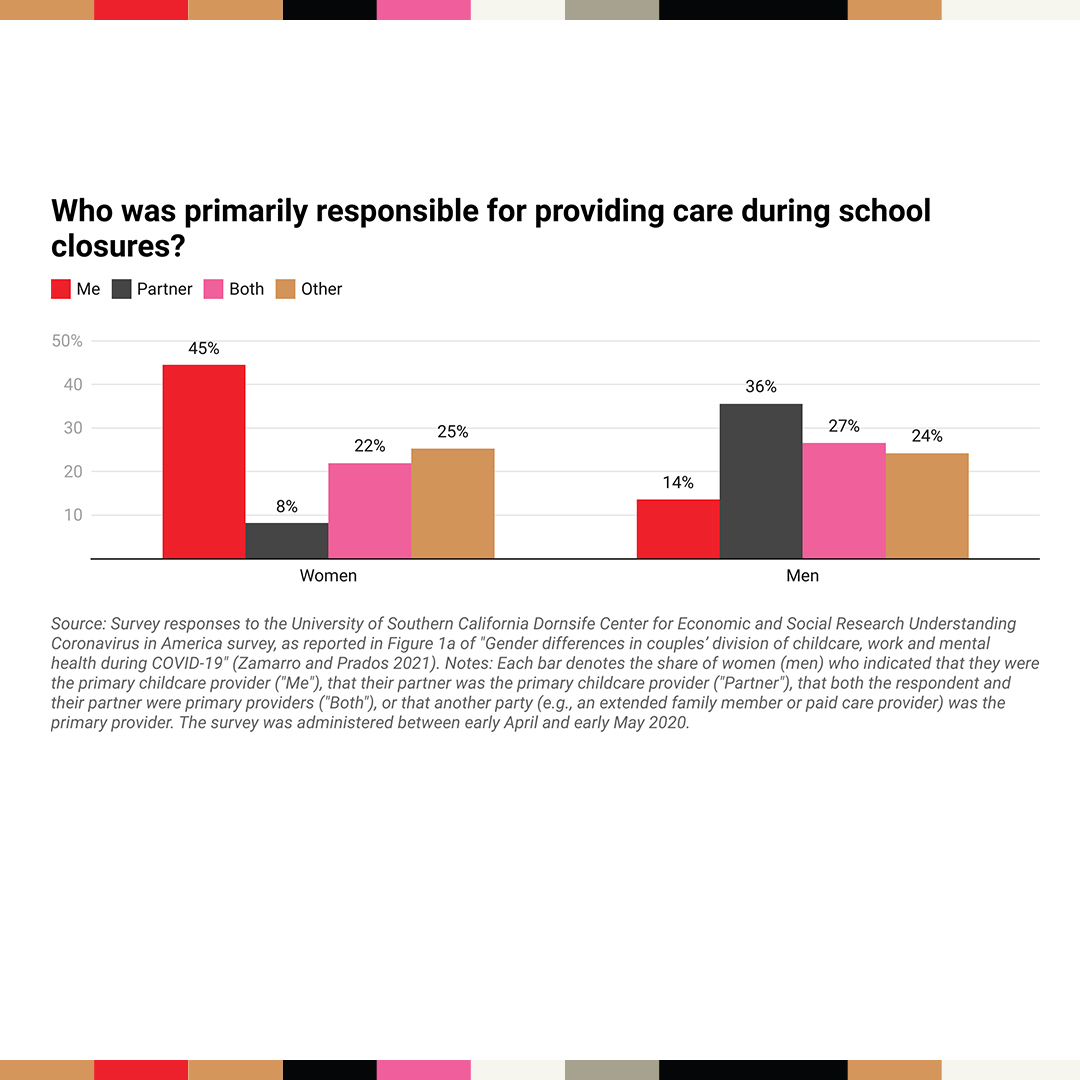
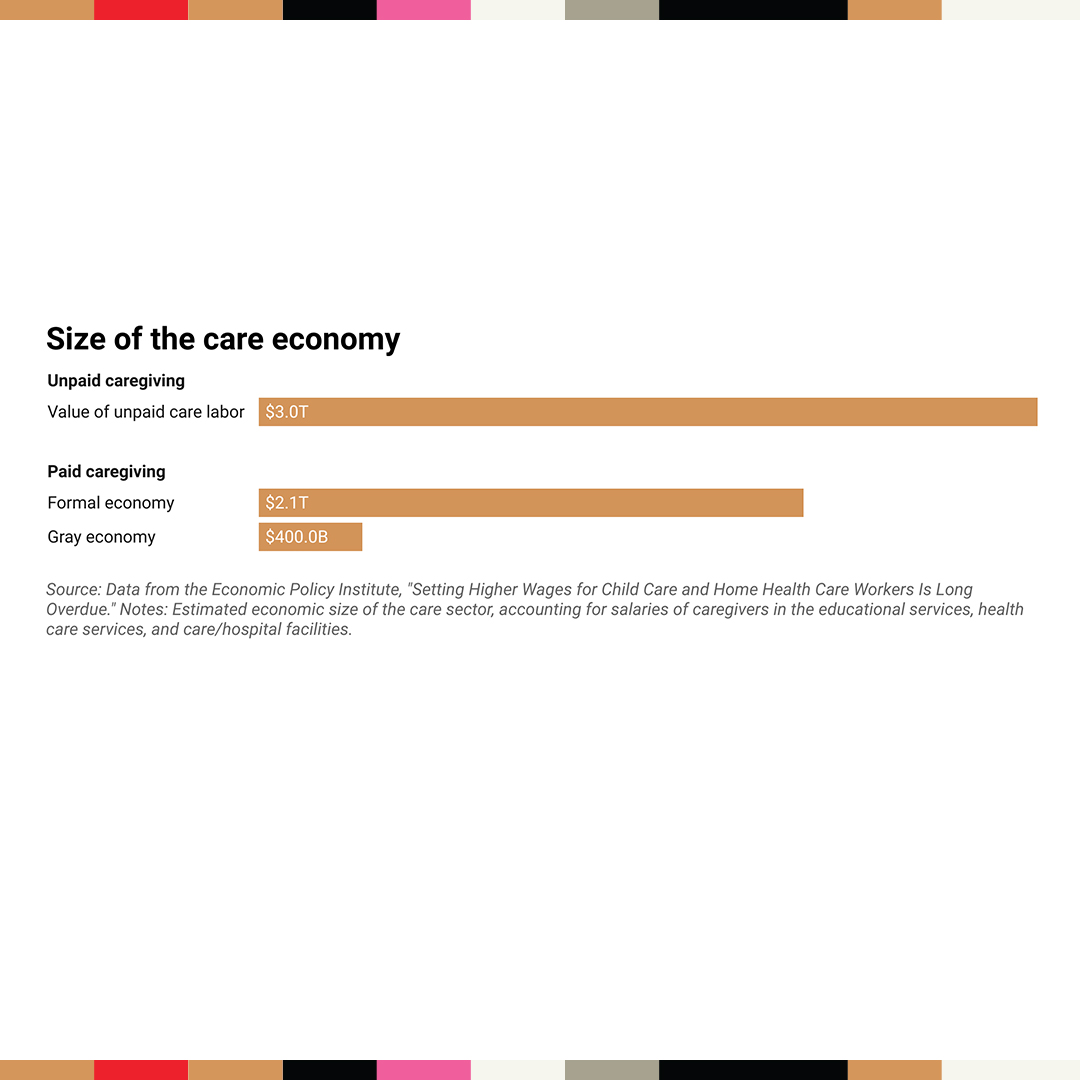
The pandemic exposed cracks in a patchwork infrastructure that disproportionately relies on the free or reduced-cost labor of women.
61.5% of mothers of children under 12 reported taking on the majority or entirely of extra care work in 2020, compared with 22.4% of fathers.
In the early stages of the pandemic, more than 1.4 million moms left the labor force in 2020 alone, with nearly 45% of women who left the workforce citing childcare as one of the reasons they left, as compared to 14% of the men who left the workforce.
The estimated value of the unpaid care labor provided by women during the apex of the pandemic is roughly three trillion dollars nationally.
Undervaluing caregiving is a critical issue we must address. Jobs in paid-care fields which are female-dominated have historically been low-wage and the average child daycare employee earns just $25,000 annually. 92% of these workers are women.
Women employed in the care industry were more significantly impacted by shutdowns and a slower industry-wide recovery than many other industries.
Childcare workers, made up of predominantly women and women of color, remain among the lowest paid workers in California. The median hourly pay for a California childcare worker in 2019 was $13.43 with approximately 1/3 of these workers on public assistance.
California has received more than $5 billion in one-time federal relief funds to support under-paid childcare providers and cash-strapped families in addition to the state’s annual appropriation from the federally subsidized Child Care and Development Fund (CCDF). State leaders have appropriated 48% — roughly $2.5 billion — of the federal funds to date to keep the underfunded subsidized childcare and development system afloat.
The childcare industry is slow to recover to pre-pandemic employment levels with childcare employment 11% down from where it stood before the pandemic.
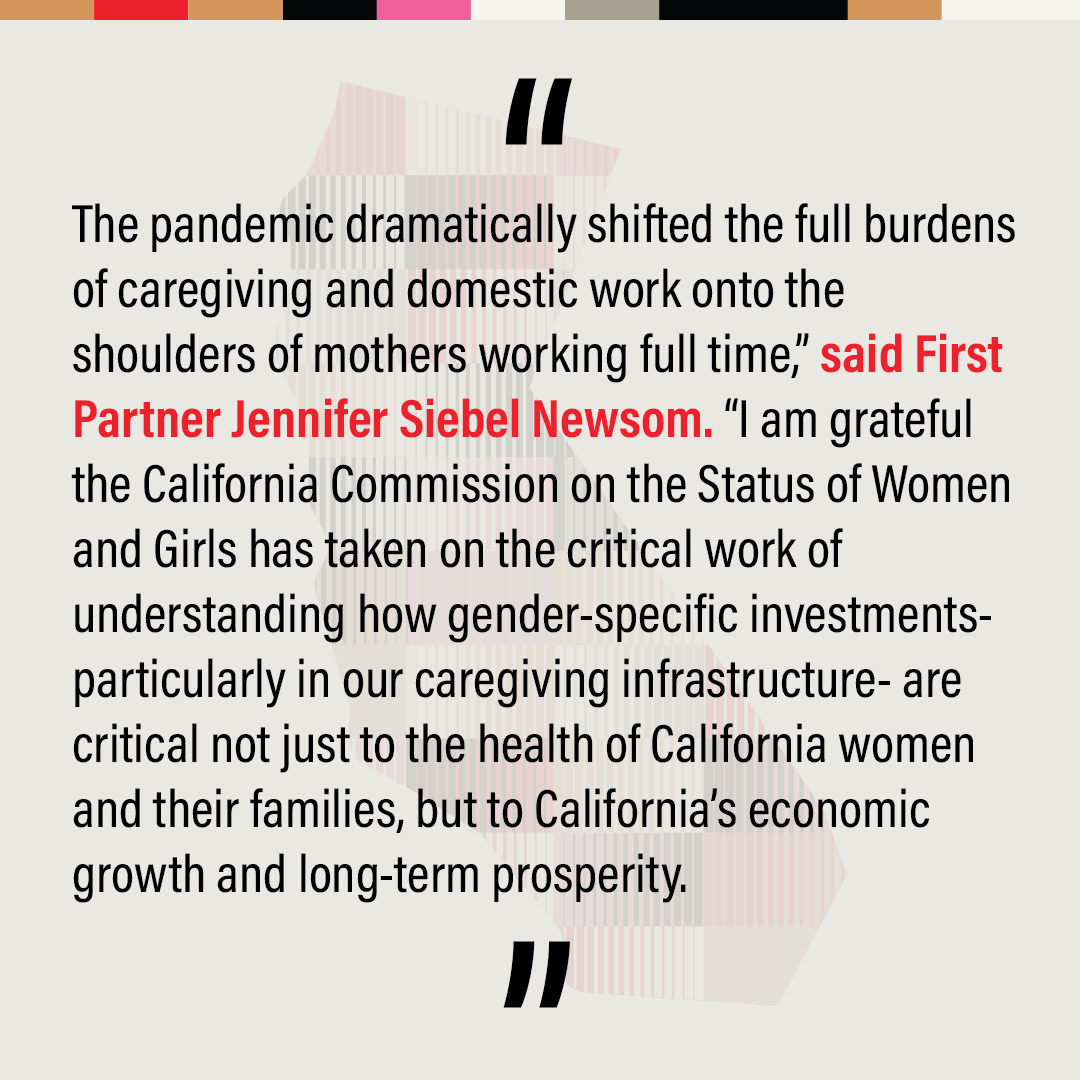
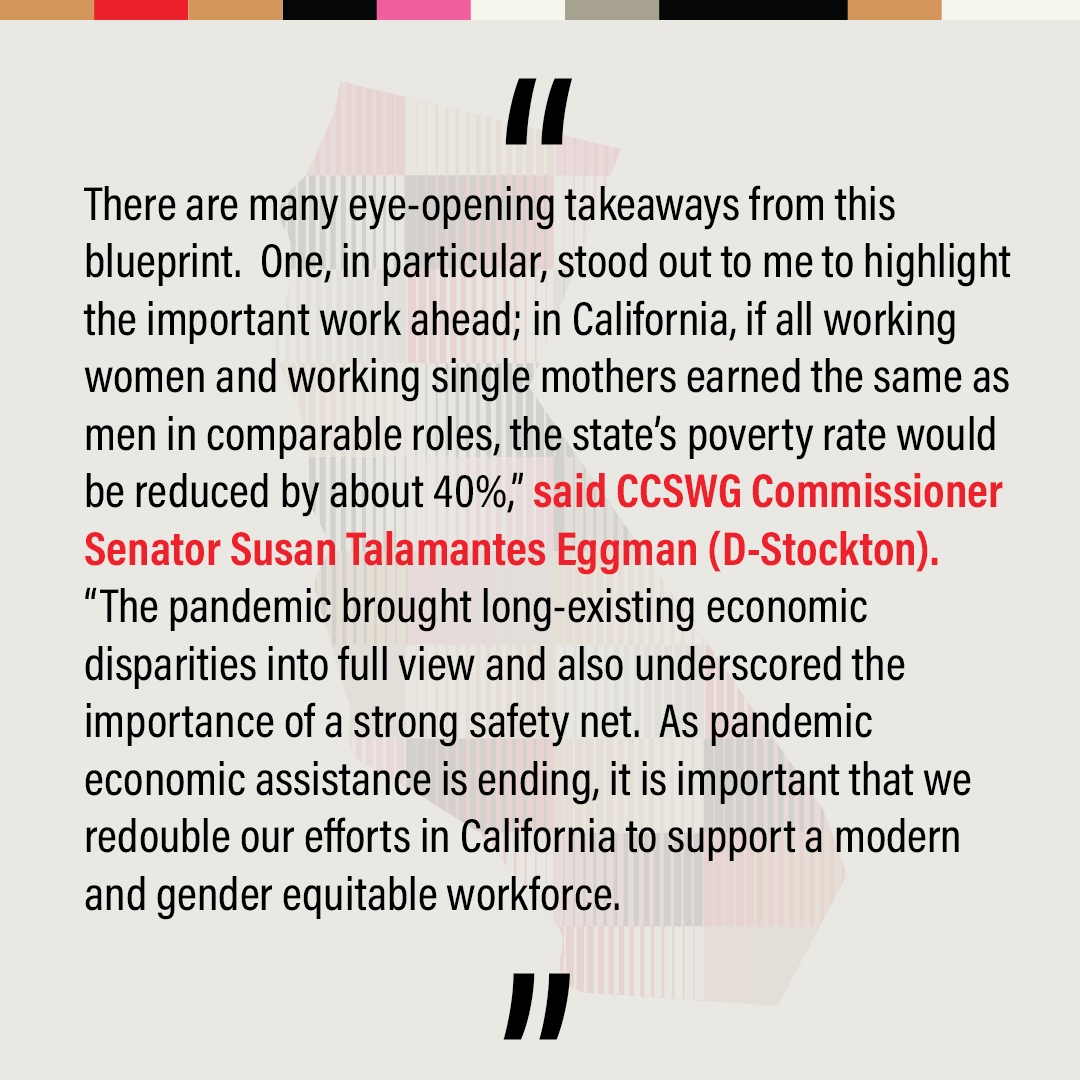
Overall, women reported experiencing disproportionate rates of psychological stress.
47% of women in California reported symptoms of anxiety or depression during the pandemic.
70% of women suffered anxiety and more than 50% experienced mild to severe depression. Women of color — more than 60% of California’s female population — continue to be the hardest hit.
An analysis of the mental health impact of COVID-19 by the Kaiser Family Foundation published in April 2021, indicated that nearly 70% of women ages 18 – 29 reported that feelings of worry or stress related to the pandemic had a negative impact on their mental health, compared with 50% of men in the same age group.
41% of mothers working from home provided extra childcare, while only 15% of fathers did when schools closed.
Social safety net support during the apex of the pandemic provided a clear path toward alleviating poverty for women and families. As these supports are withdrawn, measures of economic struggle are returning to pre-pandemic levels.
Economic support has been withdrawn and household credit card usage is now returning to pre-pandemic levels, with low-income consumers falling behind on payments. Nationally, credit card debt has seen the largest jump in a 20-year history, with credit card balances for households in the U.S. total $890 billion, and the total household debt is now more than $16 trillion.
Women make up 58% of minimum wage workers and 56% of Americans living in poverty, thus ensuring that the 2022 inflation surge was not gender neutral.
Thirty-five percent of women workers in California sought benefits, compared to 28% of men. The Blueprint further determined that between March 2020 and December 2020, Unemployment Insurance benefits reached the families of approximately 3.6 million California children, reaching about 40% of the state’s children supporting those households in the first year of the pandemic.
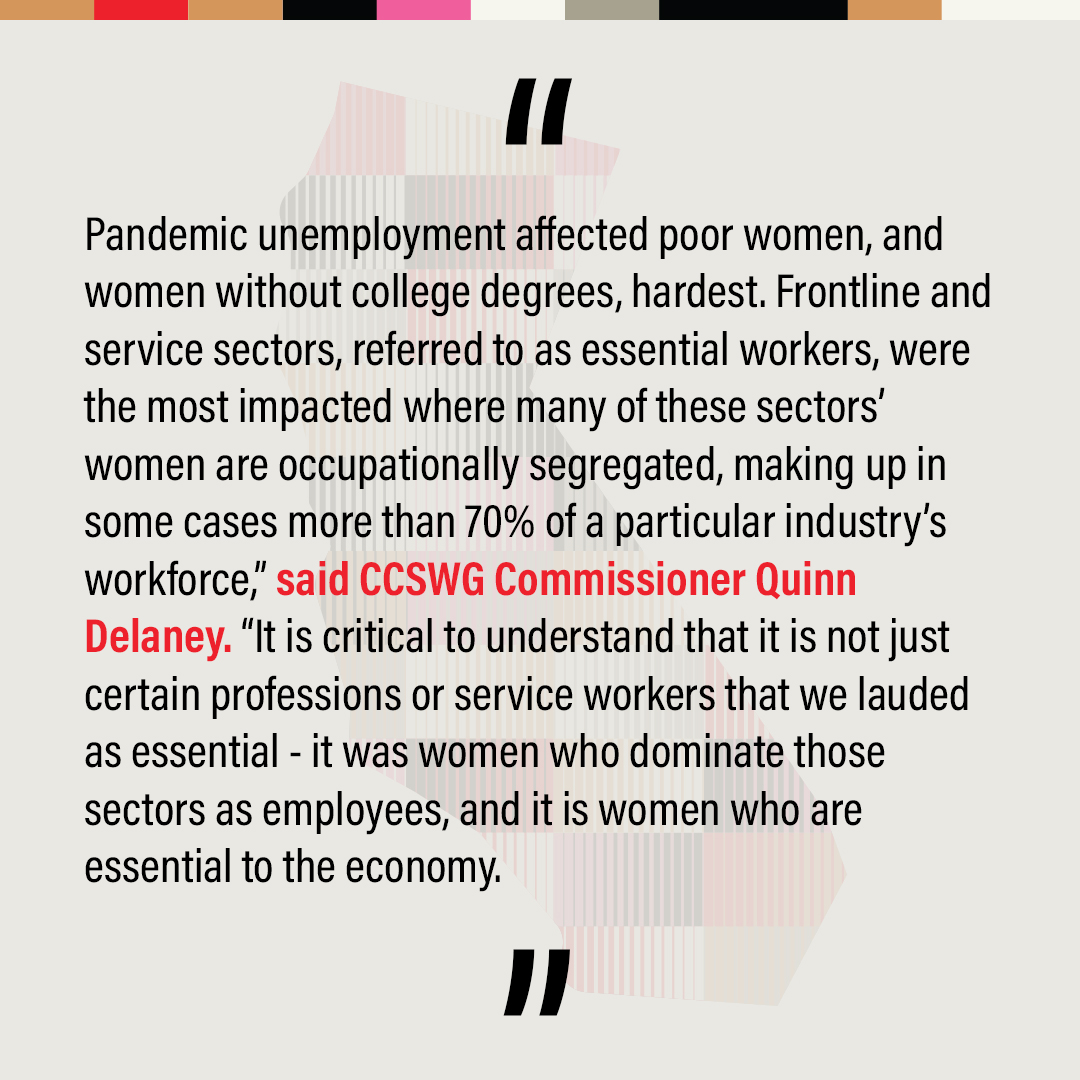
Gender is a substantive element of the health of the state’s overall workforce and capacity for economic growth and must be considered as an essential element in state resource stewardship.
California has barreled toward recovery, with overall unemployment rates falling to 3.9%, a historic low going back to the official data series started in 1976. The state as a whole has accounted for 16.1% of the nation’s new jobs as of July 2022 and has recovered all of the private-sector jobs lost during the pandemic.
One thing these numbers do not tell us, however, is the type of work, compensation, flexibility, or the intangible elements of work, including caregiving. It also does not address the lasting repercussions of the pandemic on women and families who could not afford to spend two years not working or working less. The overall hit to wealth building results in less savings, home ownership or investments or retirement savings and remains an issue for the state and the economy as a whole.
A Call to Action
CCSWG is concerned by the systematic erosion of women’s well-being, human rights, and economic status that have been profoundly accelerated by COVID-19. It will undoubtedly continue unless halted by deliberate interventions we must deploy now.
Support broad structural changes to end the gender wage gap, improve workplace equity for women, and alleviate poverty.
Solutions include: Increasing California’s minimum wage, improving pay data transparency requirements for private companies, ensuring equal pay for equal work for temporary employees, support occupational transitions, protect against workplace discrimination, and improve workplace protections.
Examine the long-term impact of Long COVID on women’s health and economic status.
Solutions include: Plan for Long COVID, improve Covid-19 reporting, improve access to sick leave, palliative care, mental health support, and prioritize accessibility.
Build more equitable and comprehensive support system for the long term to alleviate poverty and support economic recovery for women.
Solutions include: Enhance Unemployment Insurance and improve access to benefits that include Paid Family Leave, CalWorks and CalFresh. Incentivize through tax credits to include Low-Income Housing Tax Credits, Child Tax Credits, Young Child Tax Credit, and CalEITC. Dedicated support is needed for women-owned small businesses.
California must apply significant investment to address a care system that was patchwork to begin with and envision a new approach to care.
Solutions include: Affordable and accessible childcare options for families, to improving wages and incentives for the caregiving profession, investment in elder care, support in making up for lost retirement savings, increased flexibility for working parents, pilot a guaranteed income program.
Support California women in the workforce, especially in industries where they are often overlooked or under-resourced, specifically for women of color, women with disabilities, members of the LGBTQIA+ community.
Solutions include: Future research and improved data collection and transparency centers an intersectional approaches that presuppose structural gender bias and compounding challenges. Elevating women’s voices and influence on critical matters of the state through gender advisors and establishing local women commissions to improve equitable representation.

Have questions about the Blueprint? Contact me!
Darcy Totten, CCSWG Director of External Affairs
Darcy.Totten@women.ca.gov


